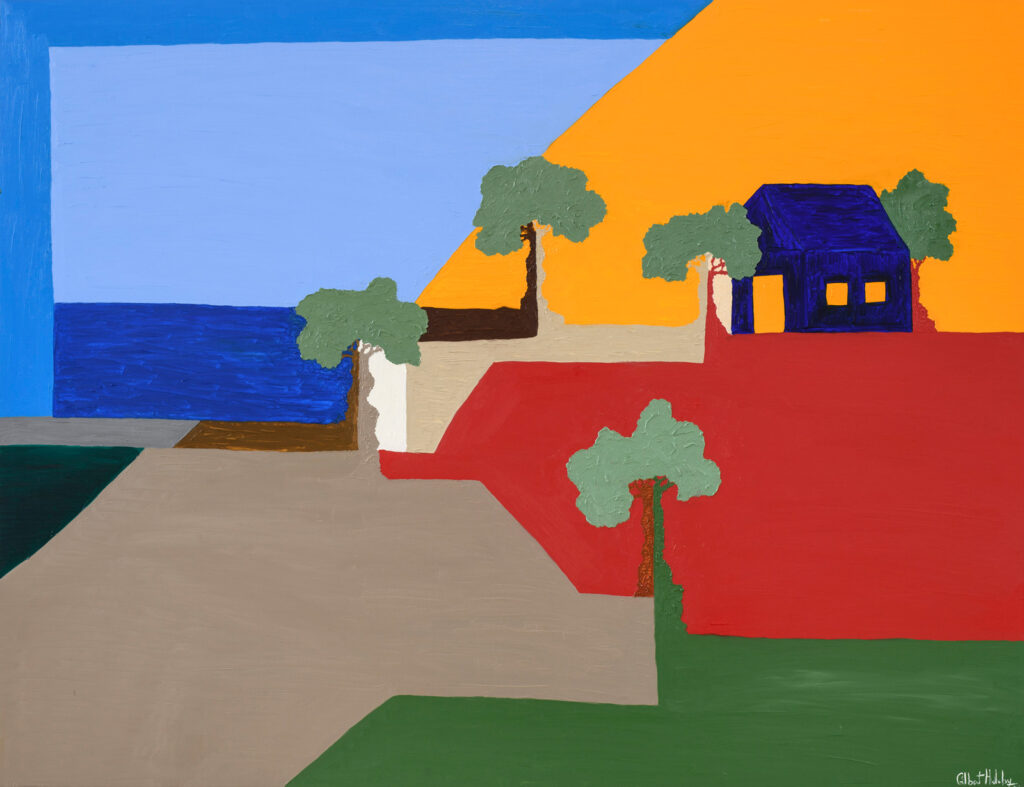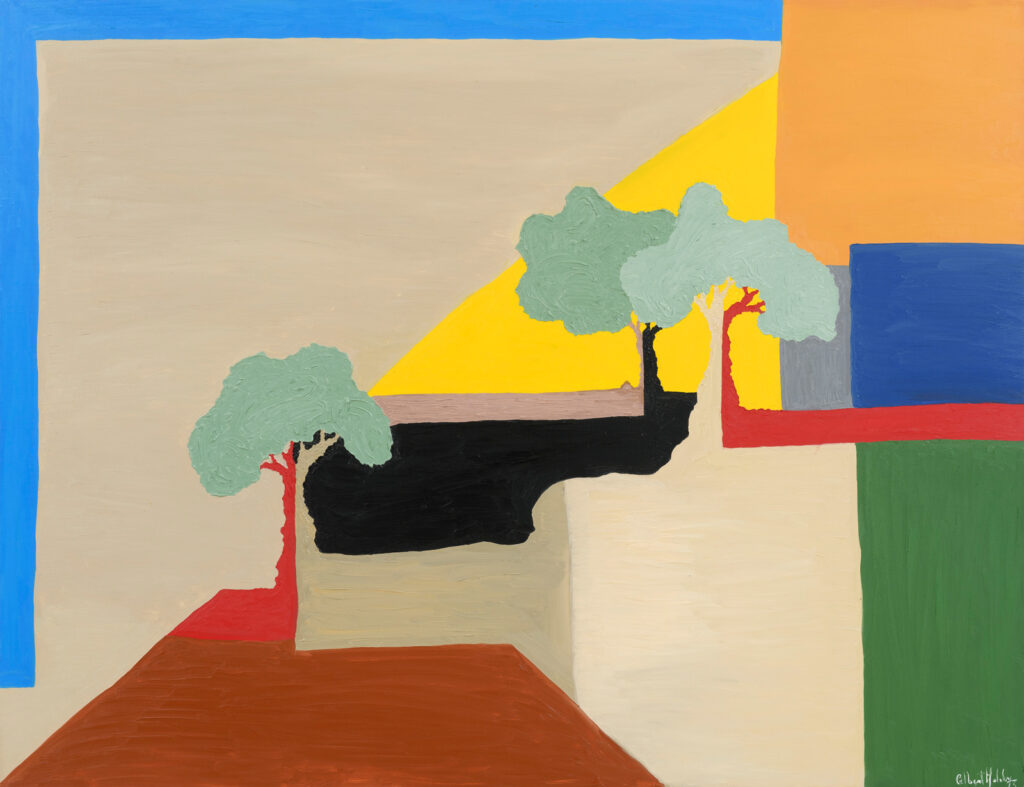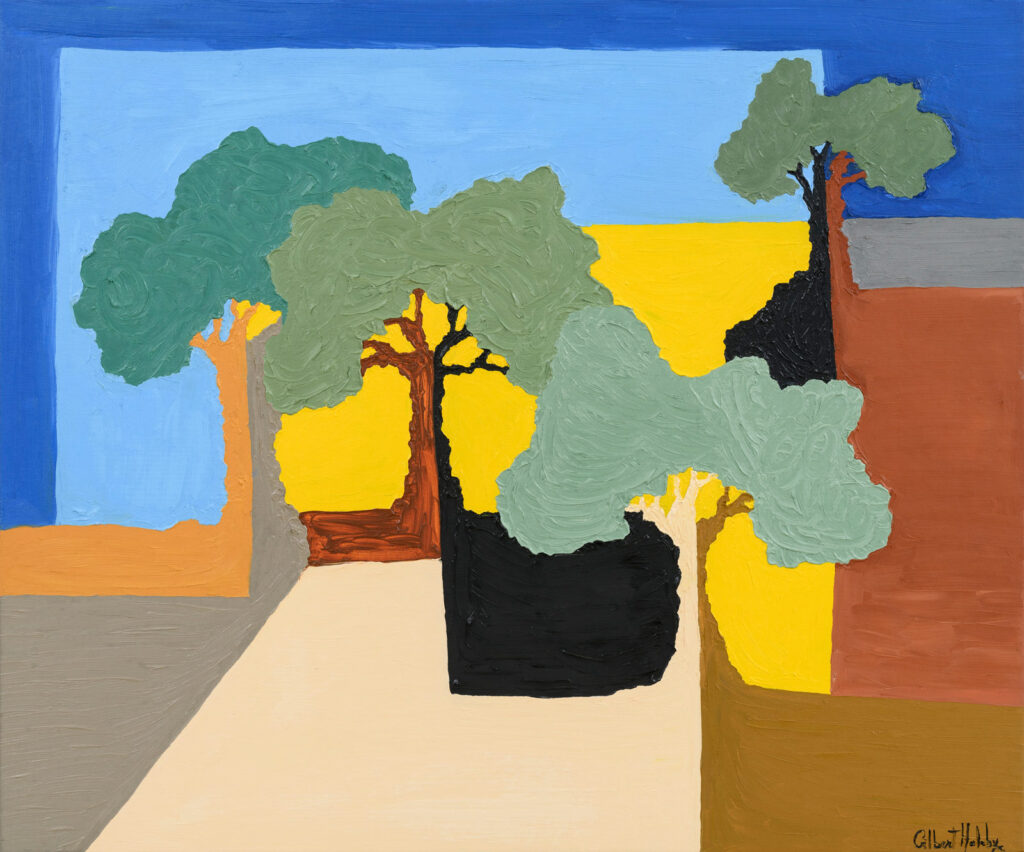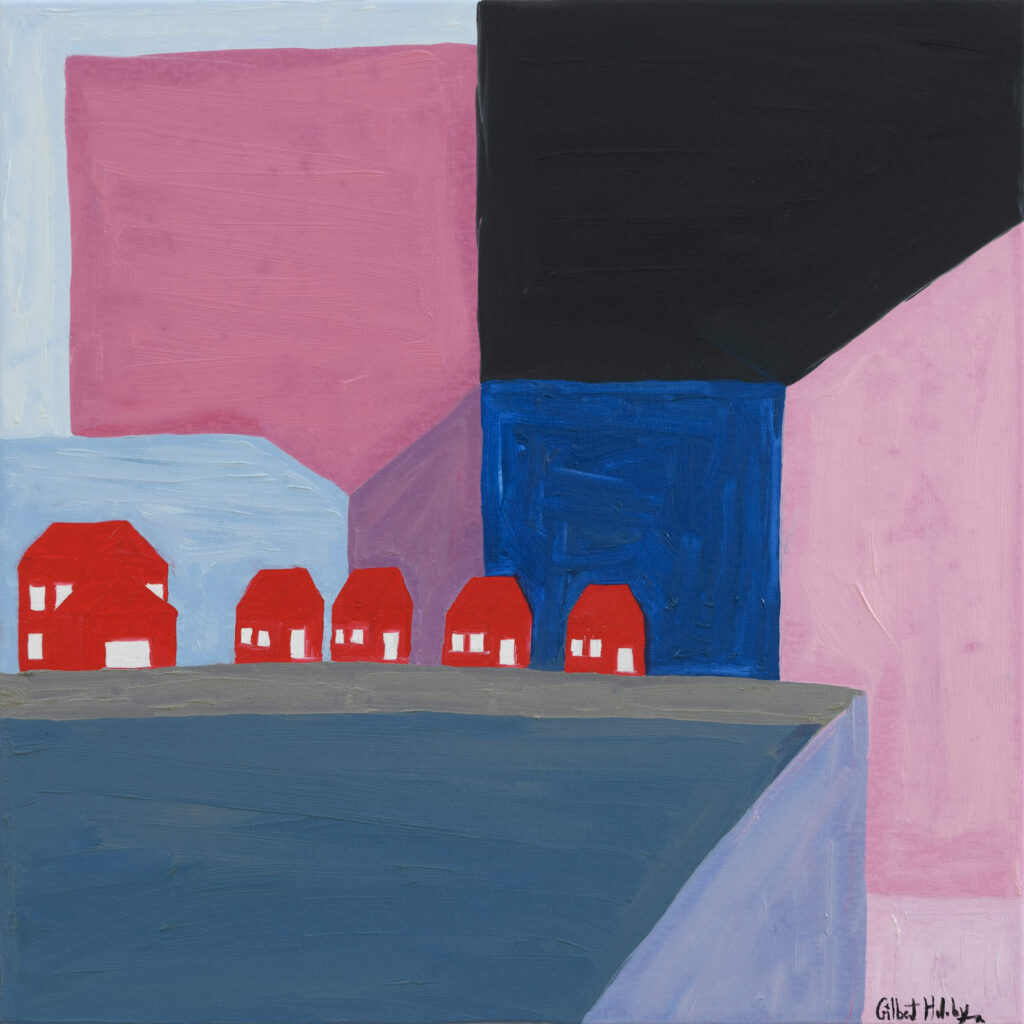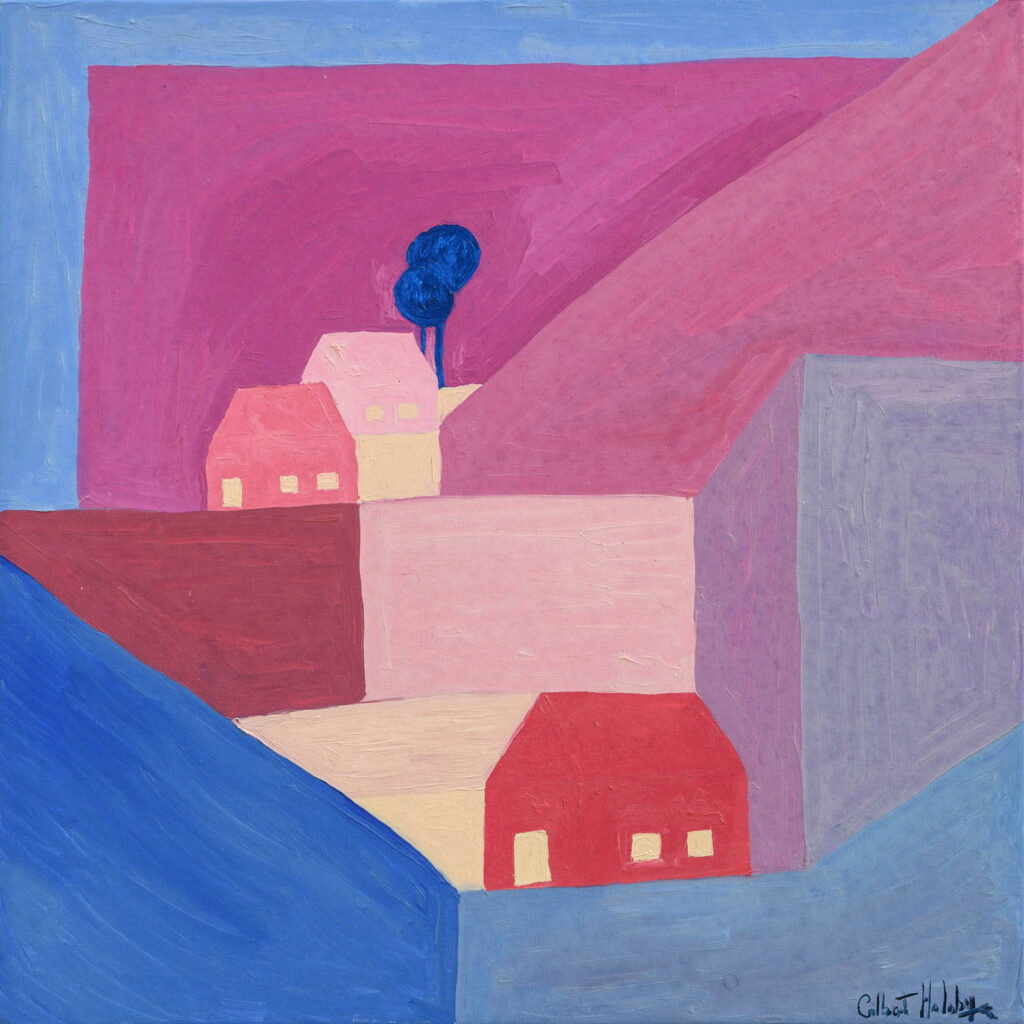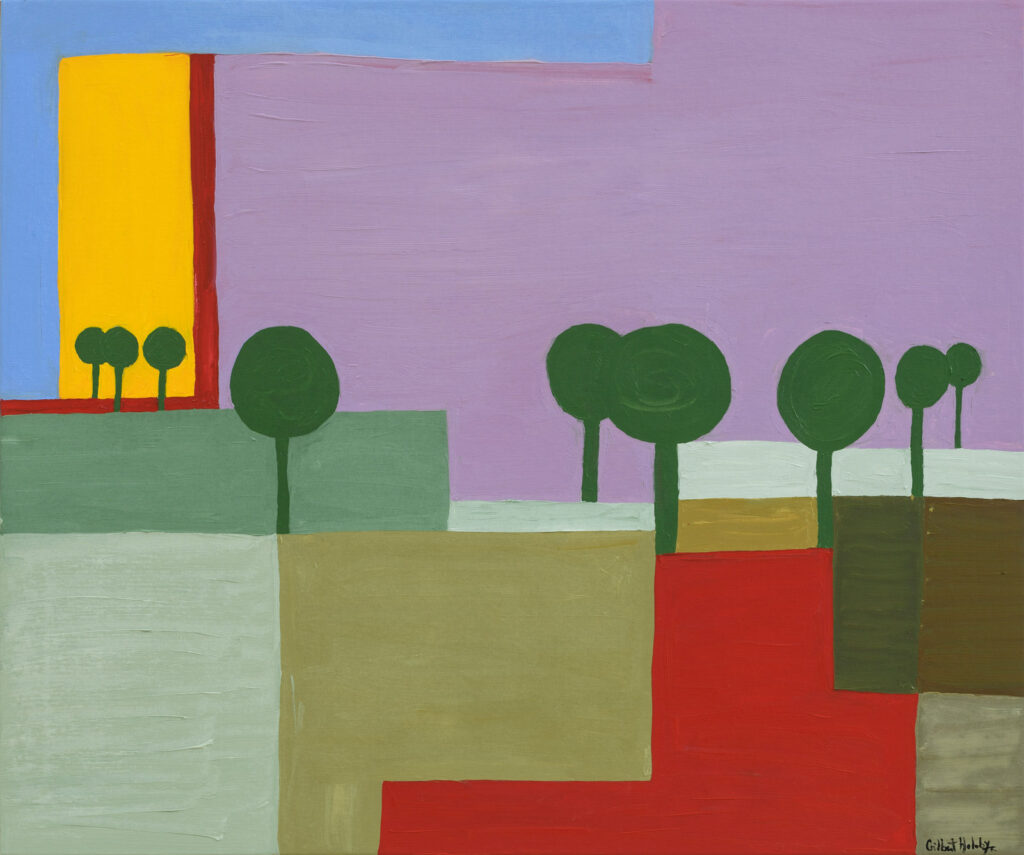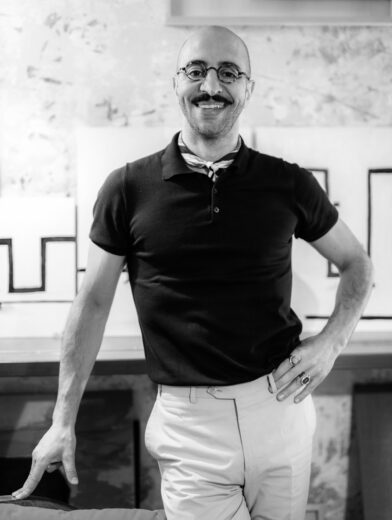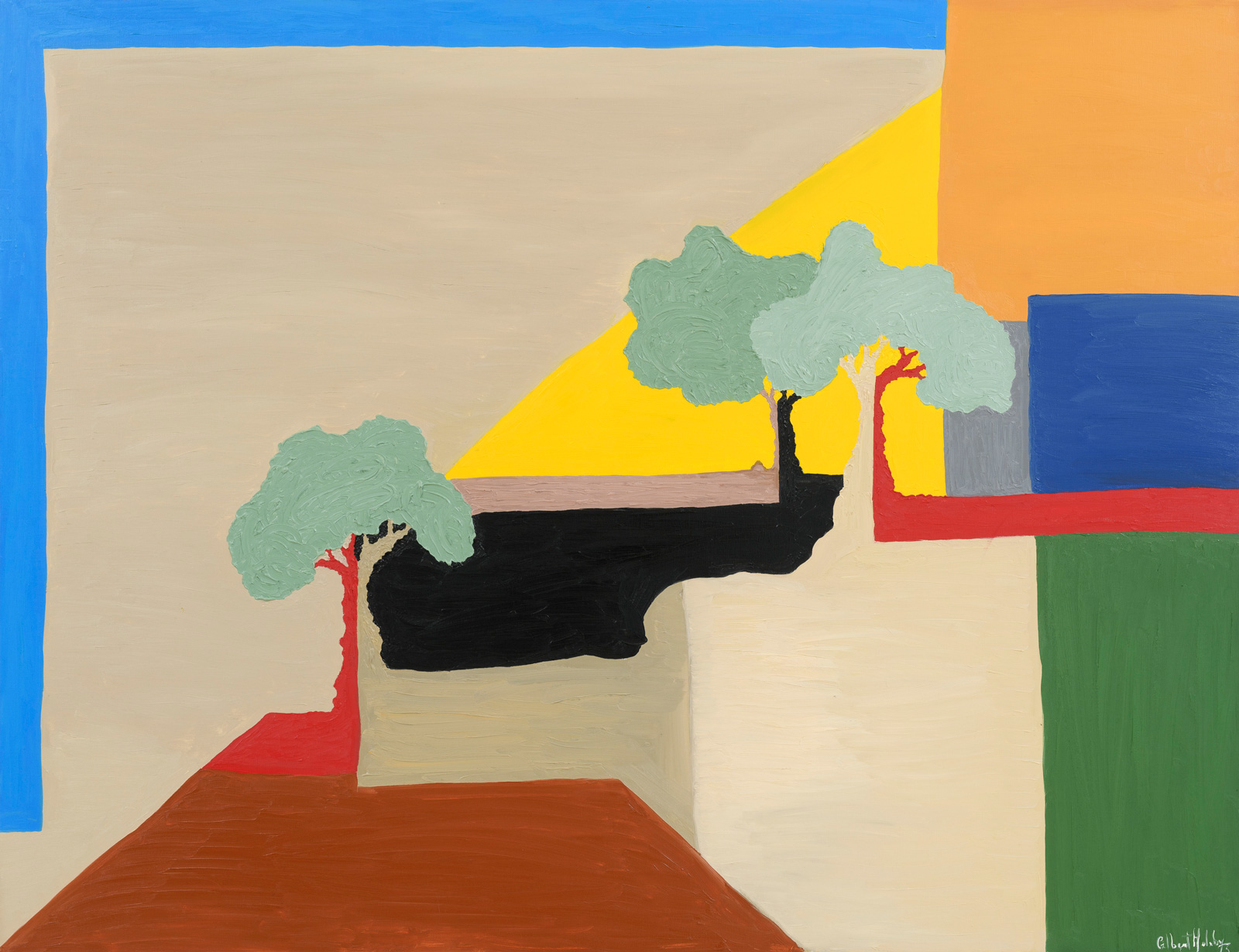
In celebration of its tenth anniversary, Maja Arte Contemporanea stages its first-ever pop-up at Casa Branca‘s new atelier in Palm Beach, featuring new works by the Rome-based Lebanese-Italian artist Gilbert Halaby. Curated by Daina Maja Titonel, the exhibition is accompanied by a catalogue which includes an essay by art historian and critic Giovanna Dalla Chiesa.
On show a selection of paintings that range across four series. There are several depicting “the everyday theatre of Rome; the serendipitous and surreal encounters of various people and personages that I see every day, within the landscape of the city,” as the artist describes them.
A second series takes the olive tree as its subject—playing both formally, with its provocative natural forms, and conceptually, with its significance as an avatar of nature’s strong, eternal beauty. “After my partner and I bought our own olive grove in the Roman countryside, and had our first harvest last autumn, I wanted to express the joy of that experience; it was always a dream to own my own olive grove, having grown up playing in the one belonging to my aunt in the north of Lebanon. The singular peace of picking the fruit, being so close to the trees and to nature, entirely away from human noise and hustle. Our vistas felt wider, the sun brighter. Our freedom felt somehow larger than before; I wanted to capture that with these paintings.” In many of the canvasses, the trunk is depicted chromatically split, often with one side rendered in red — representing the shared connection we have with the earth, through the trees.
The third series plays with the form and idea of home. The home has always been a core theme of Halaby’s art, from the time he drew them as a child. These paintings also represent an evolution of Halaby’s formal style, seeing the artist fill his canvas completely and rigorously with colour and geometry. Houses are set in the context of a paysage, but one which is deconstructed and recomposed in representative colour blocks, distilling the elements of nature to beautiful signifiers. “Everything is reduced but also amplified: the blue of the water—a brook, or lake; the yellow of the sun; the warm amber-russet tones of earth; the green that is the perennial shade of nature,” Halaby says.
Finally, Halaby engages with the idea of portraiture, via a collection of silhouettes—sometimes seen in three-quarter view, the profiles precisely rendered but the facial features themselves only hinted at. The artist privileges what the subject is regarding—often the unmistakable shape of home—as much as he does the human subject itself. “I place the portrait in the landscape always, because we ourselves seek nature, we seek home—to my mind, the natural landscape is always our natural home.” The silhouette series includes the first self-portrait by Halaby, depicting him gazing towards two cardinal ideas of his work, and life: the home, and the tree—the two most elemental forms of safe harbour.
Selected works
Critical essay
Gilbert Halaby’s “est-ethics” Art
By Giovanna Dalla Chiesa
There is something quite extraordinary about Gilbert Halaby’s personality: where elegance, simplicity, truth, and loyalty to his own principles are at ease with his commercial acumen, esprit bon vivant and serendipity.
His story is well worth being told.
After having studied archeology, Gilbert Halaby left his native Lebanon where with every step one runs the risk of stumbling over ancient Roman ruins, or those of other civilizations, and landed in Rome. In his heart of hearts, he concealed a dream: that of becoming a painter. As a child he would witness the miracle of creation when he would ever so cautiously spy on his father’s friend who would paint in complete solitude.
In Rome, in the openness of the Eternal City, where the many diverse cultures embraced by the Roman Empire were forged together to give rise to the extraordinary richness that characterizes it, the roots of which were also present in Lebanon, made itself apparent presenting him with countless opportunities. The same opportunities that the citizens of Beirut had benefited from as a colony of the empire, including the exemption from paying tax. Indeed, Rome offered him a status of privilege and freedom, which would distance him from the tragic scenarios of a war-ravaged homeland and reunite him with a mythical era, where the mosaic of those cultures had finally been recomposed.
The pragmatism that arose from the need to explore different art-related fields, such as the financially rewarding fashion and design (from which he eventually moved away) was accompanied by an unwavering desire to continue learning. This ensured an ongoing journey of self-growth, characterized by the refinement of his observation and introspection skills, made possible by his effective time management.
Gilbert’s life took shape quite naturally, moving forward on two parallel tracks: one dedicated to practical living and the other to a contemplative existence. Occasionally, these two tracks intersect, progressing at a calm pace, allowing events to unfold spontaneously.
Aren’t these the ideal prerequisites for aligning our innermost feelings in the right perspective with our surroundings?
Day after day, Gilbert Halaby has laid the foundations to break the chains of cause and effect, dictated by time, shifting into a timeless dimension where past and future are not seen as separate entities but rather as coexisting, side by side. It is a metaphysical state where the subject encounters the other, as if looking at his own reflection in the mirror.
Simone Weil contemplated: “culture is teaching how to pay attention”.
Gilbert Halaby is a keen observer, he has sharpened his senses in order to go beyond, finding himself in others. Every place in his fairytale universe represents all places, everything represents all things ad infinitum, like pursuing the multifaceted archetype that resides in the fibres of our being, pulsating with our very existence. Every tree, every home is now and always simultaneously near and far, surrounded by an enduring yet indescribable aura. It represents the home and the tree that belongs to each one of us. A sacred matter. Not an icon, nor simply an image, but a symbol. In this way, we can feel it within ourselves with devotion and foresight, even before encountering its physical likeness. In other words, these elements suggest the path and direction to embark upon our quest.
It is hardly surprising therefore, that these are the reasons why people of all extractions and cultures are increasingly recognizing his success.
In an age where nothing seems to have meaning – not even human life – where one cannot know the origin of anything, Gilbert Halaby conveys the essential – that which is purely necessary – with forms even a child would know how to decipher because they awaken the primordial root toward which all our inclinations naturally gravitate.
These minimalist forms evoke the Greek landscape, to which Halaby is attached almost as much as he is to Italy, albeit differently, where even the temples lack grandiosity and are built on a more human scale. The outline of a house is typically accompanied by little more than a tree and an animal – a goat or donkey – intrinsically associated with said landscape. In Greek, the words for painting and writing share the same root. Thus the distinctive palette, uniformly laid in Halaby’s canvases, is as much “written” as it is painted, in that the mark-making is in itself of significant importance.
Despite the importance of colour and other representational elements in his art, in several small paintings from the series “Une Comédie Romaine” (2023) the mark appears to take on the role of the protagonist. Indeed, it is the only element that underlines the focus, the trajectory and the path of the characters.
The apparently anecdotal approach which appears to guide the artist would not be as evocative nor as vivid if his ability to abstract from any ornamentation were not written in the essence of the appearances, in an ever-changing yet still scenario, as if etched in the passing of time. In doing so he avoids the temptation of resorting to caricature when dealing with narrative choosing instead to lead us back to the stories portrayed in fifteenth-century altarpieces.
Modern art has learned from the ancients the importance of observing the essence of the visible and exploring the boundaries of the invisible. The Cubists, found inspiration in the “profile” of the Egyptians, while abstract painters were drawn to the canon of Byzantine icons. In their pursuit, they recognized that writing and the alphabet, as symbolic systems, diverge significantly from our conventional understanding of “reality”. The highest spirituality has never sought to be represented; on the contrary, it transcends it.
It is interesting to note that it was the Phoenicians, a Semitic population that inhabited present day Lebanon, who invented the first phonetic alphabet, consisting of 22 characters. Vowels and other sounds were later added to those characters by the Greeks.
Therefore, it is not surprising that writing has always accompanied Gilbert Halaby’s paintings, as he uses it as a dual tool to reveal his approach to the rest of the world. The poetic fragments found in the catalogue of the “Domus Berytus” exhibition at the Beit Beirut Museum (March 2023) not only contribute to a deeper understanding of the artist’s soul, even though they are completely independent from the paintings, but they also echo the images. In each exhibition the artist has found a magnificent literary and psychological tool in the form of a letter dedicated to his adolescent self, which, as well as creating a dialogue between past and present, also defines his own universe, providing an indirect method of establishing a stronger connection with the solitary dreamer that resides within him.
Written words add a voice to visual experience.
The vibrancy of the voices in the pictorial cycle of “Domus Berytus” resembles a silent noise that spreads like a wave around the evanescent images. It evokes powerful desires and a nostalgic allure that draws every trace into the distance.
In this current stage, his oeuvre “Apogee of Light” represents the apogee of another dream, this time with a perspective: not just a house, but an olive grove.
Gilbert Halaby spent his childhood playing among the ruins of a temple surrounded by olive trees, and it was only a matter of time before he recreated the conditions to rediscover that harmony between culture and nature, an equilibrium that has always nourished him.
Creation needs to restore the delicate balance between our perception of the world and our lifestyle.
These olive trees, traversed by light and split in half inside the walls of a house, as does nature when she forcefully reclaims the spaces Man has attempted to steal from her, are a promise of future.
Many of Gilbert Halaby’s verses seem to encourage humanity towards a higher expression of life, promoting peace and understanding, culture and coexistence among all humans. From the simple strokes of his paintings we not only derive harmony and beauty but also an ethical sentiment.
His aesthetic is literally “East-thetic”. His small icons are exempla (1), like his entire life, meaning that they can be taken as an example for all.
Upskill your eyes to metamorphose into a better poet,
To scrutinize the beauty in other poems.
To take delight in what other souls left behind.
Upskill your soul
By Gilbert Halaby
(1) Exemplum (pl. exempla) is the short version, used in the Medieval literature, of a didactic and moralizing topic, a narration that seeks to provide a model of moral and ethical conduct to learn from.

